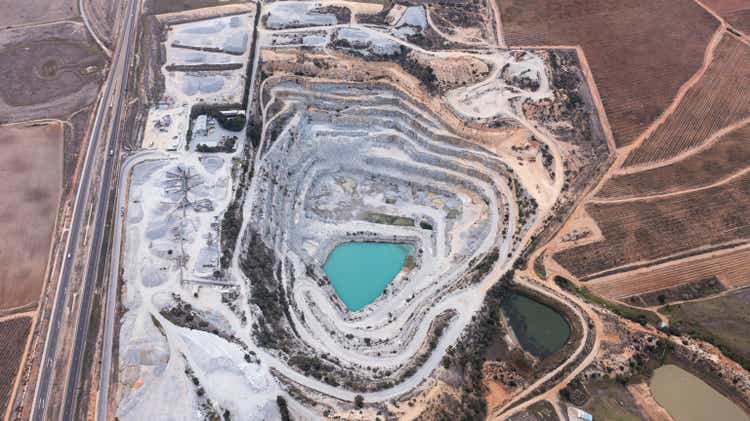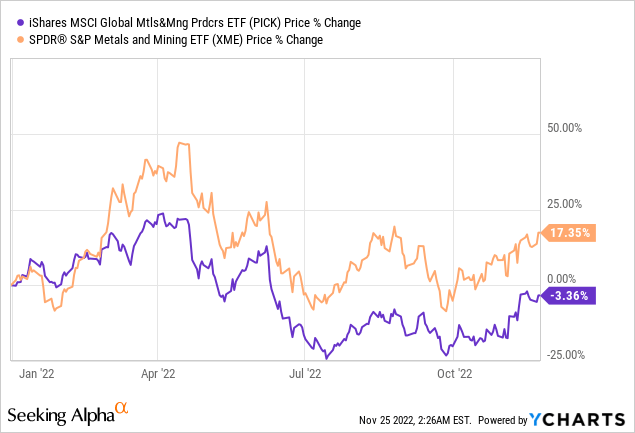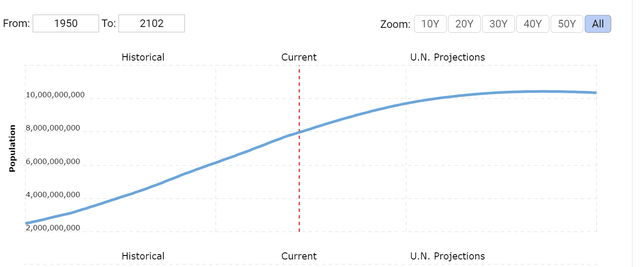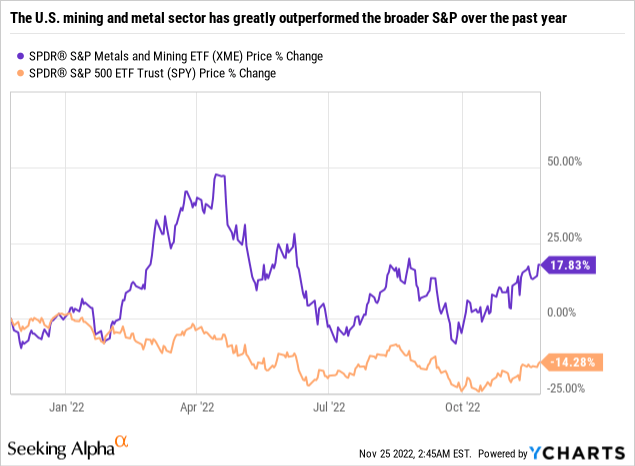Armand Burger/E+ via Getty Images
By Alex Rosen
Summary
It’s a good time to be in the extraction business, and SPDR S&P Metals and Mining ETF (NYSEARCA:XME) is having a good time. The fund which represents only American mining and mining process companies has really had a banner year at a time when the overall market has taken a trip down the well.
Globally, the demand for natural resources has never been higher. Due to combination of war in the Ukraine resulting in the banning of Russian gas supplies, the emergence from a global pandemic that has somewhat restarted global production, and increased demand for products requiring rare earth metals, the mining and extraction sector is booming.
We rate XME a buy for the simple reason that it focuses on an extremely high demand sector and is in a region where political stability and economic factors have created an ideal situation for continued prosperity.
Strategy
The ETF offers investors access to the U.S. extraction and extraction processes market. The fund focuses on the following sub-industries: Aluminum, Coal & Consumable Fuels, Copper, Diversified Metals & Mining, Gold, Precious Metals & Minerals, Silver, and Steel. It does so in an equal weighted index which allows for broad access to large, medium and small cap stocks.
Proprietary ETF Grades
- Offense/Defense: Offense
- Segment: U.S. Equity
- Sub-Segment: Mineral extraction
- Correlation (vs. S&P 500): High
- Expected Volatility (vs. S&P 500): Low
U.S. mining and metals founds greatly outperform similar global funds (Ycharts)
Data by YCharts
Holding Analysis
XME’s equally weighted portfolio strategy should prevent the overbalancing of any one stock, and a review of the holdings reflects that. Currently the three largest stock holdings, Peabody Energy (BTU), Hecla Mining (HL), and Steel Dynamics (STLD) each comprise less than 5% of the total fund and represent three different sectors: energy, gold, and steel.
The fund holds a total of thirty-six stocks, with the top ten representing 41% of the total assets. From a sector standpoint, it is more weighted toward non-energy extraction, but still has a stake in the energy sector, and the manufacturing/process sector.
Strengths
Funds that focus on too broad a sector tend to get lost in defining what and who they are. For example, an emerging market fund can literally focus on anything and still claim to be true to its intent. A green energy fund can define green energy any way it chooses and still get away with calling itself green. XME calls itself a U.S. metals and mining fund, and lo and behold it is. With 100% of its assets in U.S. stocks and focused specifically on metal and mining, this fund does what it sets out to do.
Recently the world population crossed the 8 billion threshold. That number keeps rising, and with it, the demand for resources grows. More people means more mouths to feed, more homes to build and heat, and more cellphones to sell. All of these require base elements, and that is what XME is selling.
World Population continues to grow. Can resources maintain pace? (United Nations – World Population Prospects)
Weaknesses
One country, one sector. It is a fairly binary model. When demand is high, it’s great. However, it only takes a few small shocks to turn the whole strategy on its ear. Tomorrow, the Russian sanctions could be lifted, and the pipelines might start flowing again. Maybe China will start increasing steel production and dump it in the U.S. Perhaps the 13 trillion dollar gold strike in Uganda will flood the market causing gold prices to drop. Any of these could have a significant effect on the performance of XME, and its lack of diversity leaves it exposed to a higher degree of risk.
Opportunities
Even if, suddenly, the infamous Russian winter leads to a cessation of hostilities, the lingering bad taste means it will be a while before Europe starts relying on Russian oil and gas. Even then, it will never go back to the way it was. Just last week, Germany opened its first LNG liquefaction plant for the purpose of importing LNG from abroad (Hello U.S. LNG exporters). The plant was built in two and a half months, and is the first of many to come online in the near future.
China is choking from its own toxic coal clouds, and is still struggling to contain a pandemic the rest of the world seems to have moved on from. If anything, the production of steel and other metals may go down rather than increase.
As for gold, it seems to be the one good where supply does not have a direct impact on price. Yes, the Spanish empire collapsed because they flooded the gold market (the inbreeding of royalty did not help either), but gold continues to be the currency that marks all other currencies.
As long as XME keeps its focus, it should continue to show solid returns.
Threats
Despite how some funds define emerging markets, the U.S. fully moved into Developed nation status after World War I. American companies operate at a level of sophistication that is hard to match. These companies aren’t looking at the immediate future, but rather months and years down the road. The increases in stock prices and profits we see today are a result of years of planning. One such example of companies looking to the future, is in the LNG sector, where companies built import plants at a time when U.S. law prohibited the export of natural gas. However with that eye toward the future, they were designed to be easily retrofitted for export. Sure enough ten years later the laws were changed and now they are exporting at record levels. The risk with U.S. companies lies not in falling behind, the global demands, but rather in overcapacity. Plenty of investment is poured into what are perceived as potential opportunities, and when those opportunities come to fruition, they can produce fabulous returns, however when the demand decreases, they are sometimes stuck with excess supply and extra production capacity.
Proprietary Technical Ratings
- Short-Term Rating (next 3 months): Buy
- Long-Term Rating (next 12 months): Hold
Conclusions
ETF Quality Opinion
XME is clear in its intentions and follows through on it. No tricks, no fancy models, just plain salt of the earth holdings. The fund has a low expense ratio (.35%) and the index is rebalanced quarterly. Whether you like its objective or not is up to the individual investor preference, but the model is sound.
ETF Investment Opinion
Due to its focus on U.S. assets and the sectors it invests in, we rate XME a Buy. While one day things will turn around and the desire to extract at least in America will decrease. But for now, the demand is there and increasing. This demand is reflected in how the fund has performed in comparison to what the overall market is doing.



Be the first to comment